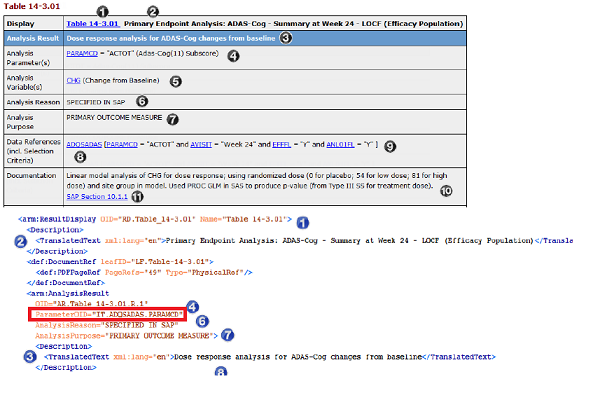ARM Section - Analysis Parameter
Forums: Define.xml
ARM Section - Analysis Parameter
There are no tables in Define-XML ... there is only the XML ...
The tables that you see in the browser are a result of the applied stylesheet.
So, is your question about the stylesheet? Or is about the XML?
For such issues, looking into the source XML (e.g. using NotePad++) is always the first thing you should do.
Best regards,
Jozef Aerts
Define-XML development team
ARM Section - Analysis Parameter
Thanks Jozef.
My question about Analysis Result in the define xml.
In the CDISC sample, we have only ONE dataset PARAMCD [screen shot below].
My question is : is there possibility to give >1 ParameterOID per AnalysisResult?
Because, in our study - in the data references row, there are 2 BDS datasets referred with its corresponding PARAMCD's and able to display only one dataset PARAMCD in Analysis Parameter(s) row. But expectation is to display both datasets PARAMCD's in the Analysis Parameter(s) row.

 Sergiy
Sergiywhy do you need to merge 2 ADaM datasets for analysis?
Hi Gopal,
It looks like you may have some issue with implementation of ADaM standard.
ADaM datasets must be "analysis-ready". See ADaM- IG section 2.1:
ADaM datasets should have a structure and content that allow statistical analyses to be performed with minimal programming. Such datasets are described as “analysis-ready.” ADaM datasets contain the data needed for the review and re-creation of specific statistical analyses.
It means that there is no need to combine or merge ADaM datasets for analysis. That's why Analysis Results Metadata assumes a use of a single BDS dataset for analysis result. Analysis Parameter(s) is displayed by a stylesheet which extracts it from selection criteria in BDS datasets. You may have multiple Analysis Parameters within one BDS dataset.
So, why do you need to merge 2 ADaM datasets for analysis?
Kind Regards,
Sergiy
ARM Section - Analysis Parameter
Thanks for your inputs. I agree your points.
This is client expectation / request. So, we tried to see whether it is possible to implement.
As per ARM V1.0 document --> Section 4.4 (Analysis Datasets) : we can have possibility to display >1 datasets. But there is no specific information like "it shouldn't contain >1 BDS datasets". In this case, if both are BDS datasets then we need to display both domains PARAMCD's in the Analysis parameter row. Please correct me, if I am wrong.
4.4. Analysis Dataset(s) Definitions
As part of the analysis results metadata, it is important to identify the name of the dataset or datasets used to generate the analysis result. In most cases, this is a single dataset. However, if the analysis result requires joining multiple datasets, all of the datasets and a comment describing the join or how the multiple datasets are to be used can be provided. In addition to the dataset or datasets, the selection or subset of records used for the analysis and the analysis variable or variables to be analyzed should be described as part of the Analysis Dataset(s) Metadata.
 Sergiy
SergiyTry to see if you can add…
Try to see if you can add more than 1 BDS dataset in selection criteria
ARM Section - Analysis Parameter
Hi Sergiy,
I added 2 BDS dataset names in Data references [Selection Criteria] - It displays 2 BDS names in Data references row as per below screen shot.
But we are able to give Only one domain PARAMCD in ParameterOID per result. I wanted to know whether it is limitation [Only one ParameterOID per result].

thanks.
 Lex
LexARM Section - Analysis Parameter
Hi Gopal,
I was one of the authors of the ARM specification.
Indeed, the ARM specification only allows one ItemDef to be defined as the parameter. It is an attribute, so also technically it is impossible to have 2 attributes with the same name.
You could solve this by reusing this Item in both BDS datasets.That means use the same ItemOID for the PARAMCD variable in both BDS datasets.
Having said this, I agree with Sergiy, that it does not seem to be a good design to have to merge (or stack) 2 BDS datasets for one analysis result.
Best,
Lex
ARM Section - Analysis Parameter
Thank you so much Lex and Sergiy for detailed explanation.






Hi,
ARM Section : Analysis Parameter row : Would like to know, whether is it possible to display Only one data set PARAMCD's OR can we list out more than one data set PARAMCD's in this row?
The table generated based on more than one BDS data sets. So wanted to display more than one data set PARAMCD's in the Analysis Parameter row.
Thanks.